#GM Motorama
Text

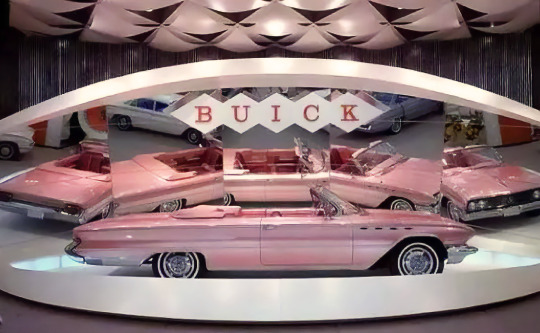
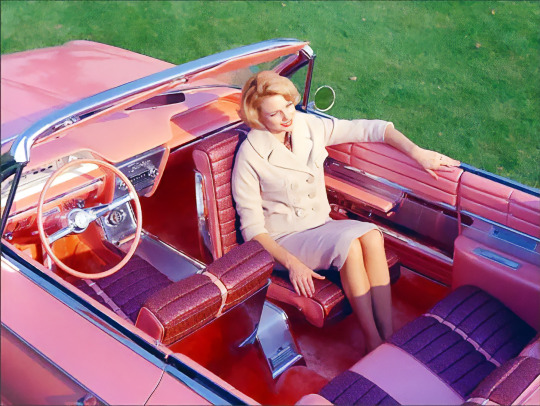
Buick Flamingo Show Car, 1961. One of Buick's entries in the final GM Motorama was a heavily accessorised Electra 225 Convertible. Non-standard items included pearlescent pink finish, a custom interior featuring two-tone upholstery in pink leather contrasted with cranberry brocade and a pivoting passenger seat, which could turn through 180º to face the rear passengers.
#Buick#Buick Flamingo#Buick Electra 225 Convertible#Buick Electra Flamingo#pearlescent pink#pink cars#GM Motorama#General Motors#General Motors Motorama#1961#custom car#convertible#open roof#swivel seat
802 notes
·
View notes
Text
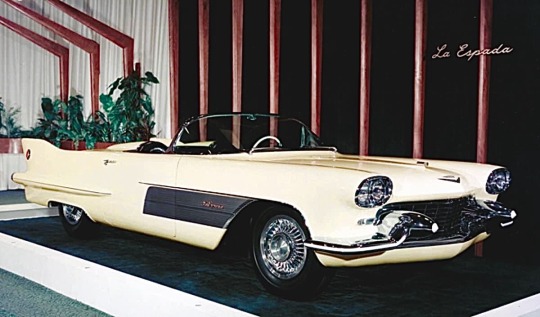
The 1954 Cadillac La Espada concept was a driveable show car first shown at the 1954 GM Motorama
93 notes
·
View notes
Text
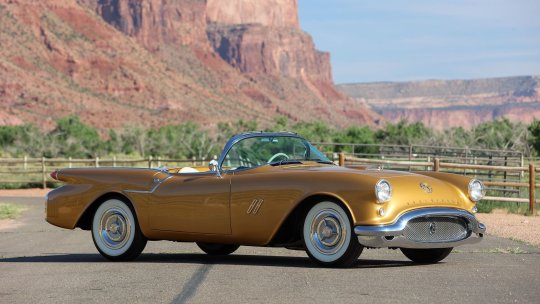

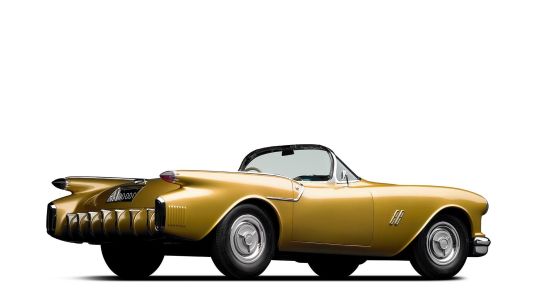

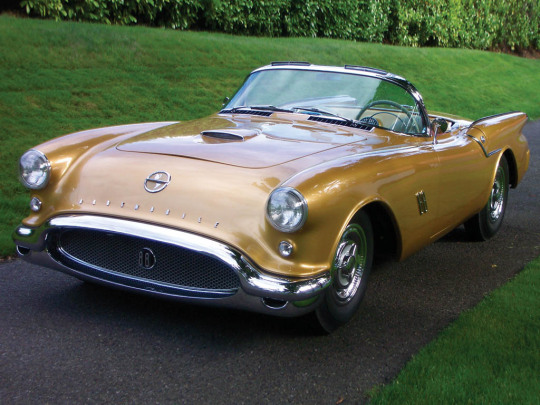



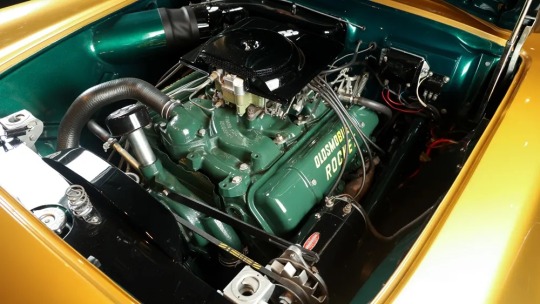

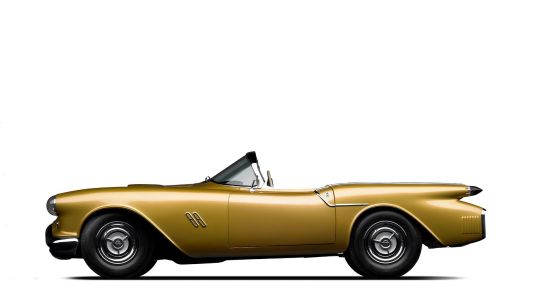


1954 Oldsmobile F-88 Concept
The 1954 Oldsmobile F-88 concept car, and the only remaining example of this iconic GM Motorama creation. Supplied directly from GM as a knocked-down “kit” to legendary automaker E.L. Cord.
Known internally as project XP-20, the Oldsmobile concept was designed in the spirit of Chevrolet’s 1953 Corvette: a two-seat sports car with a 102-inch wheelbase and fiberglass body.
But its details define the Oldsmobile F-88 concept as something far more visionary, offering a glimpse of the future in the shape of its fenders, tail fins, exhaust outlets, and use of chrome. And GM spared no expense, with custom trim and hardware like front fender vents cleverly disguised behind cast “F88” emblems.
Its interior was upholstered in pearlescent-finished pigskin, a material impossible to offer with production-line models. Unlike most concept cars, the F-88 was not a pushmobile, but powered by Oldsmobile’s 150 hp, 324 cubic-inch V-8 engine, mated to GM’s Hydramatic transmission.
The car is powered by Oldsmobile’s 150 hp, 324 cubic-inch V-8 engine, which is mated to GM’s Hydramatic transmission.
#art#design#supercars#luxurycars#supercar#luxurylifestyle#luxurycar#vintage cars#oldsmobile#F-88#concept car#car concept#hydramatic#GM
577 notes
·
View notes
Text

1956 Oldsmobile Golden Rocket
Bullet on Wheels: The 1956 Oldsmobile Golden Rocket
Easily one of the wildest General Motors dream cars of the Motorama era, the Olds Golden Rocket was the epitome of Jet Age design. Let’s take a closer look.
Throughout the 1950s, Harley Earl and his forward-looking crew at the GM styling studios frequently turned to aircraft and space travel for their inspiration. There might be no better example of the automaker’s guided-missile design theme than the far-out Golden Rocket, Oldsmobile’s Motorama dream car for 1956. “The Supersonic Age comes to automobile styling!” the company proclaimed.

1956 Oldsmobile Golden Rocket
Constructed in fiberglass on a shortened Oldsmobile passenger car perimeter frame with a 105-inch wheelbase, the Golden Rocket was essentially a bullet on wheels in side view (above.) But under the skin, the show car was fairly conventional with a 324 CID, 275-horsepower Olds Rocket V8 up front, Hydra-Matic automatic transmission, and leaf-spring rear suspension. The custom wheels employed integral brake drums, and a pair of fuel tanks were housed in the rear fenders. Note the “dotted-line” segmented whitewalls, a novel feature that never went any further.
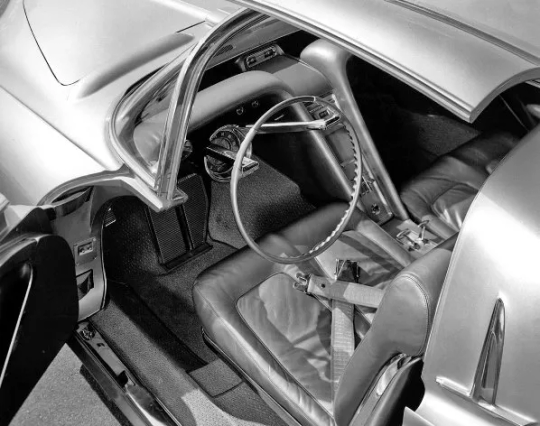
1956 Oldsmobile Golden Rocket
At a little more than 200 inches long but less than 50 inches tall, the Rocket sported an impressively low silhouette, which required some ingenuity in the packaging of the two-seat cabin. For easier entry and egress, a roof panel popped up when the door was opened on either side, while the steering wheel rim swung upward and the bucket seats rose three inches and pivoted on their mountings. Upholstery was blue and gold leather, while the speedometer was housed in the steering wheel hub. The lap belts and driver pedals display a strong aircraft influence.
While the Rocket seems to be one of the more obscure GM dream cars in current times, it did include some ideas that turned up later on the General’s production models. The stubby rocket-type tailfins would adorn some memorable Cadillacs of the early ’60s, while the split-window teardrop rear window is extremely familiar. It was next tried on a dead-ended 1958 Corvette styling proposal, then famously appeared on the 1963 Corvette Sting Ray coupe. As with a number of GM Motorama dream cars, the fate of the Golden Rocket was not officially documented, reportedly, but it hasn’t been seen or heard from in years and is presumed destroyed.

1956 Oldsmobile Golden Rocket
123 notes
·
View notes
Text



#cars#car#classic#classic cars#classic car#concept#concept car#vintage#general motors#firebird#firebird ii#fast car
114 notes
·
View notes
Text
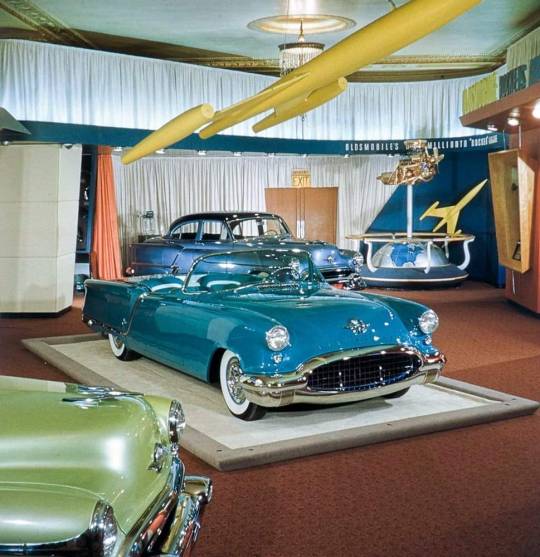
The Oldsmobile Starfire concept car at a GM Motorama in 1953....
11 notes
·
View notes
Text

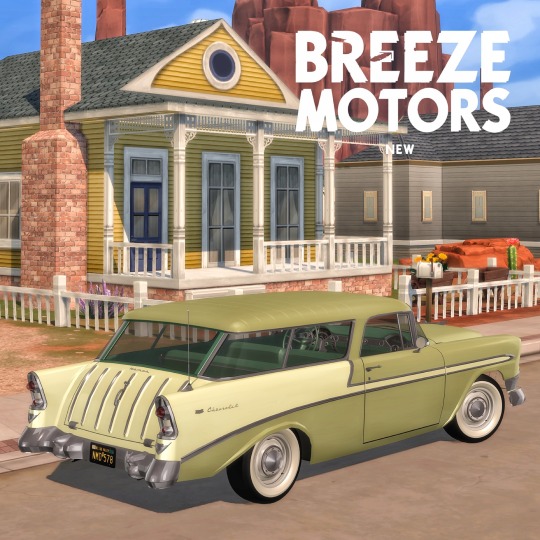
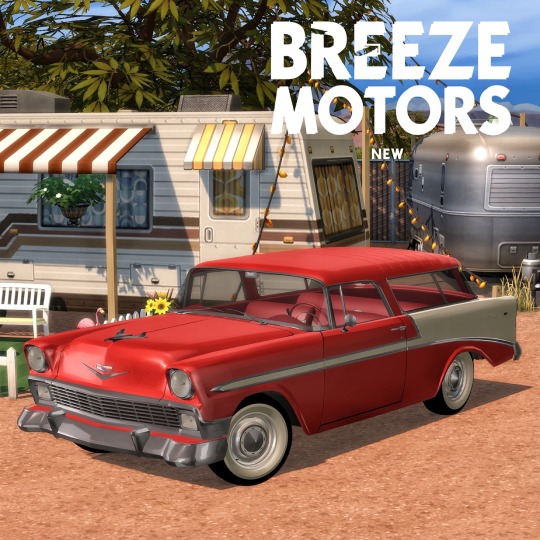




“Bel Air Nomad”
1956 Chevrolet Bel Air Nomad 🇺🇸
The first Chevrolet Nomad was conceived by Harley Earl and based on a Corvette platform. It debuted at the 1954 GM Motorama show. After a warm public reception, the Nomad was placed into production for 1955 and joined the top-echelon Chevrolet Bel Air passenger car line to become the first GM 2-door station wagon. The original Nomad continued as a low-production (by Chevrolet standards) image leader for the 1956 and 1957 model years.
Available exclusively for “No Limits” and “All Inclusive” tiers.
Model with HQ interior, open/close doors, tailgate and functional light.
Go and join my Patreon!
#the sims 4#sims 4#sims4#sims4car#the sims 4 cc#the sims 4 custom content#thesims4cars#the sims 4 cars#sims4vehicles#the sims#the sims 4 cc finds#sims 4 cc finds#the sims 5#sims 4 cars#sims 5#sims 4 cc#the sims custom content#sims 4 alpha cc#sims
31 notes
·
View notes
Text
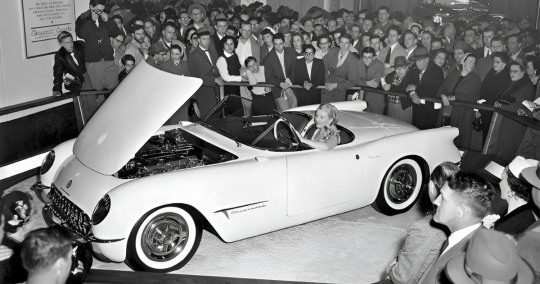
📅 On this day in 1953, the iconic Chevrolet Corvette made its grand debut at the Waldorf-Astoria Hotel in NYC during GM's Motorama. Designed by Harley Earl, it was the first all-fiberglass-bodied sports car mass-produced in the U.S. The initial 300 Corvettes were hand-built in Flint, Michigan, sporting a polo white convertible body, red interior, and black top. 👌 A Blue Flame six-cylinder sat under the hood connected to a two-speed automatic transmission.
Fast forward to 2024, and now we have an electric-hybrid Corvette, the E-Ray! ⚡️ Could this car usher in a new generation of Corvette history?
#corvette #automotivehistory #chevy #chevrolet
3 notes
·
View notes
Photo

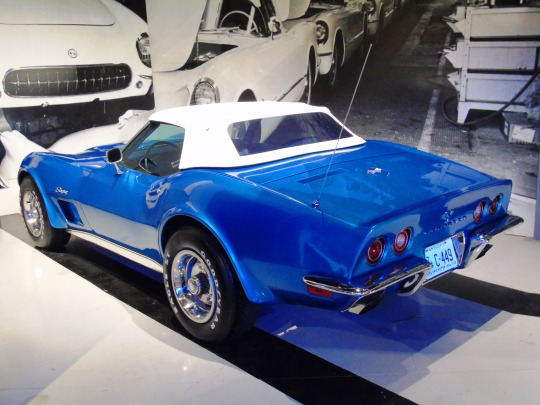

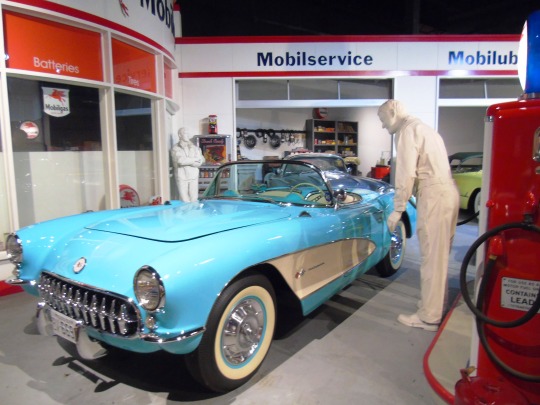





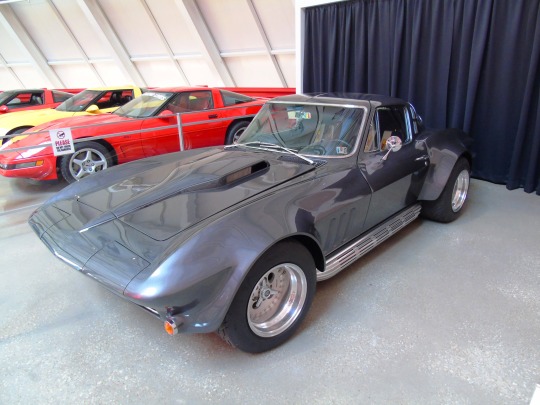
The first Chevrolet Corvette rolls off the assembly line in Flint on June 30, 1953.
National Corvette Day
An American icon in the world of automobiles, the Corvette represents freedom, speed and victory. Learn more about the history of this classic car and celebrate it on National Corvette Day!
History of National Corvette Day
Emerging as the unique sports car design in an otherwise rather boring line of vehicles for General Motor’s Chevrolet brand, the Corvette brought a new vibe in 1953. Premiering at New York City’s GM Motorama Show, the Corvette was a sports car that came off the Flint, Michigan assembly line a few months later–on June 30.
The original model of this car got off to a slow start – selling only 183 out of the original production of 300. But when the 1957 Corvette Super Sport was born, it quickly became legendary with its V-8 engine and up to 225 horsepower. Since that time, the Corvette has been a symbol of speed and sport for several generations.
The Corvette logo is two flags on crossed poles. One of the flags is checkered to symbolize the race, while the other is the American stars and stripes flag to symbolize the place of its production.
National Corvette Day is celebrated on June 30, giving a nod to the day the first Corvette rolled off the assembly line back in 1953. It was in June 2008, in honor of the 55th anniversary of this classic car, that the United States House of Representatives passed a resolution that the day would be known as National Corvette Day.
How to Celebrate National Corvette Day
For car lovers, National Corvette Day is a simple one to enjoy, complete with delightful activities such as:
Visit a Car Museum or Exhibit
Enjoy the fun of National Corvette Day by taking a look at some classic cars. Of course, the ideal place to visit on this day would be the National Corvette Museum located in Bowling Green, Kentucky. Established by a non-profit foundation in 1994, this museum exists to celebrate, preserve and educate about the past, present and future of the Corvette.
It’s also possible to become a member of the museum, joining almost 40,000 other Corvette enthusiasts from all over the world. Individuals, families, businesses and clubs can all join on different levels, whether annually or even for a lifetime. Members have access to free admission, magazine subscriptions and discounts as well as other fun benefits.
Enjoy a Local Celebration
Many Chevrolet and GM dealers in different locations will host open houses and events for community members to visit and look at different models of Corvettes that might be on sales floors. Or perhaps they will use the day to bring in some models that are normally in private collections.
Drive Your Corvette
Of course, the most obvious answer to celebrating the day for Corvette owners is to take a little spin. Convertible owners can even roll down that top and make the neighbors jealous. Or, even better, offer to take them for a short ride around the block and make it a time for everyone to get in on the celebration of National Corvette Day!
Source
#Chevrolet Corvette#National Corvette Museum#USA#travel#30 June 1953#70th anniversary#US history#Bowling Green#Kentucky#summer 2016#vacation#engineering#technology#car#tourist attraction#landmark#indoors#original photography#Chevy#Southeastern Region
2 notes
·
View notes
Photo

GM Design Unearths Stunning 1955 GMC L’Universelle Concept. These days, the minivan is considered a soulless transportation brick to ferry the brood to and fro. However, back in the ‘50s, GMC had something much more stylish and desirable in mind, as evidenced by the following concept photos recently unearthed by GM Design. What we have here is the 1955 GMC L’Universelle, a vehicle considered an early precursor to the minivan. However, unlike the current crop of minivans, the 1955 GMC L’Universelle concept was simply dripping with style and sex appeal. Pulled from the GM Design Archives & Special Collections, these photos were recently posted to the official GM Design Instagram feed. Making its debut at the 1955 Motorama show, the GMC L’Universelle included a front-mounted 287 V8 engine driving the front wheels. As such, the vehicle provided oodles of space in the rear for, well, whatever you could imagine. The design was penned under the direction of Harley Earl and Charles Jordan, and featured gullwing doors for easy access to the cabin space, as well as a rear door section that would lift up for easy access to the cargo area. The name is French for “the universal,” an appropriate title given the concept’s myriad applications. At the time, General Motors envisaged the vehicle’s use as a delivery truck, taxi, bus, or station wagon, as well as transportation for outdoor enthusiasts. In addition to a wide variety of possible uses, the 1955 GMC L’Universelle was simply gorgeous to look at as well, with large bumpers, tail fins, and a two-tone color scheme with pink on silver. Unfortunately, the 1955 GMC L’Universelle never made it beyond the concept stage. However, the design did provide a inspiration for production vehicles to follow, such as the Chevrolet Corvair Greenbriar. 📷 Source: gmauthority.com www.CDLhunter.com #gmc #gmctruck #gmctrucks #gmcsemi #gmcdaily #truckin #trucklife #logistics #truckerhat #liftedtrucks #trucknation #truckporn #trucker #truckdaily #truckerslife #transport #truckshow #truckerlife #cdljob #cdljobs #cdlhunter 🚛 Follow @cdlhunter 📲 Call or text us at (347) 878-2591 for a driving job — view on Instagram https://ift.tt/ZTQ54Ly
4 notes
·
View notes
Text
The 1954 Oldsmobile F-88 is one of the most famous concept cars to ever emerge from General Motors. Unveiled at the 1954 Motorama auto show, the radical F-88 featured futuristic styling and performance that wowed crowds. Although the F-88 never made it to production, it influenced later GM designs and remains a highly coveted collector car today. This article takes an in-depth look at the history, design, legacy and value of the legendary 1954 Oldsmobile F-88 concept car.
Overview of the F-88 Concept
The Oldsmobile F-88 was a dream car showcasedby GM at the 1954 Motorama auto show. Designed by Harley Earl's styling division, the F-88exemplified 1950sera automotive futurism. It had a fiberglass body,a 324 CID Oldsmobile Rocket V8 engine, and could reportedly hit 140 mph.
Only four F-88 cars were built as Motorama showpieces. While some concept cars preceded production models, the F-88 was never mass produced. But its radical design previewed styling cues adopted on later Oldsmobiles. Today, the F-88 remains one of themost famous dream cars of all time.
The History Behind the Oldsmobile F-88
Origins at General Motors
The F-88 traces back to GM's Motorama auto shows from 1949-1961. Motorama showcased futuristic concept cars to generate excitement about automation. Harley Earl's styling division spearheaded these flashy prototypes.
The F-88 was designed for the 1954 Motorama. It wasone of several dream cars spotlighted that year, alongside the Oldsmobile Cutlass, Pontiac Bonneville Special, andBuick Wildcat II.
The F-88 on Display
Four F-88 cars toured across the country's major citiesas part of the 1954 Motorama. Two were convertibles, one a hardtop, and one afastback. They awed crowds with their radical styling and alleged 140 mph top speed.
F-88design cuesappeared on later Oldsmobiles,like the 1955-56 Super 88. But GM never approved the F-88 for production. Most show cars met this fate, since theywere designedmore for publicity than feasibility.
Mystery of the Remaining Cars
After Motorama ended, the fate of the four F-88 cars was unknown. Rumor long held that GM had them destroyed. But in reality, at least two survived.
One was purchased by the president of an Ohio Oldsmobile dealership. Anotherended up with Gordon Apker, an engineer involved with the XP-20 project that spawned the F-88. Apker's family retained the car for decades.
In 2005, the Apker F-88 resurfaced when it was purchased by a noted collector. Itmade headlinesbeing showcased at high profile classic car auctions. The identity of the current owner remains undisclosed.
Design Details of the 1954 Oldsmobile F-88
The F-88 exemplified 1950s automotive fantasy with its spaceship-inspired design. It looked unlike any production car of its era.
Exterior Styling
The F-88 had afiberglass bodywith a prominent grille, tailfins, and a cockpit-style interior. Its front end styling was low and wide compared to production 1954 Oldsmobiles. The car measured over 17 feet long and 6 feet wide.
Some key exterior design features included:
Sweeping front fenders with integrated headlights
Large chromed grille and bumper extending below it
Curved windshield and fastback rear window
Prominent tailfins on the rear fenders
Rocket-style trim details on sides
Flashy two-tone paint schemes
Overall, the F-88 conveyed motion and aerodynamics. Itlooked like it was gliding down the highway.
Interior Design
Inside, the F-88 embodied a futuristic 50s aesthetic. The two-seat cockpit had aircraft-influenced gauges and detailing. Distinctive features included:
Bucket seats with linen upholstery
aircraft-style dashboard and console
full instrumentation including tachometer
Y-shaped transmission shifter
integrated air conditioning system
The interior was designed for both comfort and performance. It exemplified space age styling of the era.
Engineering Specs
The F-88 was powered by a 324 CID high compression Rocket V8 taken from a production Oldsmobile 88.
Horsepower was rated at 250 HP, with a 4-barrel carburetor and 10:1 compression ratio.
The engine linked to a GM Hydra-Matic transmission. With its fiberglass body, the F-88 weighed under 3,000 pounds. Road tests estimated its top speed at 140 mph, very fast for the mid 1950s.
So while the F-88 was not drivable long-term, it had real performance credentials. This engine power awed Motorama audiences.
The F-88's Influence on Oldsmobile
Although the F-88 did not reach production, it influenced Oldsmobile styling throughout the 1950s. Elements of its radical design gradually made their way onto road cars.
Inspiring the 1955-56 Oldsmobile 88
Possibly the most direct descendent of the F-88 was the 1955-56 Oldsmobile Super 88. The production 88 borrowed several styling cues from the F-88, like the low and wide front end, C-shaped bumper, and prominent tailfins. The 88 evoked the futuristic aesthetic of the F-88 in a production-ready form.
Mainstreaming Space Age Styling
Beyond inspiring the Super 88, the F-88 spearheaded the aviation and space age styling direction GM design chief Harley Earl envisioned for the future. Its prominent tailfins, cockpit interior, and aerodynamic shape previewed the styling of late 50s cars.
Elements like tailfins and bucket seats became mainstream. While toned down from the F-88, its innovations started influencing production cars. The F-88 showcased styling that Earl wanted to make commonplace.
Concept Car Influence
The F-88 was also influential in cementing the importance of concept cars for GM. It showed the value of dream cars for previewing revolutionary designs, even if they didn't reach production. GM expanded its use of futuristic prototypes after the F-88's success.
In many ways, the F-88 was a pioneer that shifted concept cars from being pure fantasies to influencing production vehicles. It demonstrated their potential impact on future styling.
The F-88 on the Collector Car Market
Today, the legendary F-88 resides among the most valuable concept cars ever built. The few surviving examples have sold for huge sums at auction when they rarely trade hands.
Rarity Adds Value
With only four examples built, intact original F-88s are incredibly rare. Of these, only two are known to still exist. The scarcity makes any example coming to market a major event that attracts heavyweight collectors.
Rarity alone makes the F-88 a blue-chip collectible. But its status as an automotive icon also drives desirability. It remains one of the most famous dream cars ever created.
Notable Auction Sales
The Apker family F-88 went to noted collector Lon Krueger's shop in Arizona in the early 2000s. After restoring it, Krueger's shop sold it to another prominent collector.
This car made headlines when it sold for $3.24 million at Barrett-Jackson's 2005 Scottsdale auction. That shattered the record price for a concept car.
In 2007, it traded hands again at RM Auction's Monterey sale. This time its price climbed to $4.82 million. The F-88 has continued to appreciate as a crown jewel among collectors.
Who Owns Surviving Examples?
The current owners of the two known surviving F-88 cars remain undisclosed. After its multimillion dollar auction sales, the ex-Apker car disappeared into another prominent collection.
The identity and history of the other extant F-88 is less documented. But it likely resides with a major collector of 50s dream cars. The elite status and value of the F-88 restricts ownership to top enthusiasts.
5 Key Facts About the Oldsmobile F-88
Four F-88s were constructed as Motorama concept cars. Two were convertibles, one a hardtop, the other a fastback.
The F-88featured radical aviation-inspired styling that previewed late 1950s production cars.
It was powered by a 324 CID Oldsmobile Rocket V8 engine paired to a Hydra-Matic transmission.
The F-88 heavily influenced the 1955-56 Oldsmobile Super 88 production models.
Surviving examples have sold for multi-million dollars at auction, establishing the F-88 as one of the most valuable concept cars ever.
Why The F-88 Remains an Automotive Icon
The 1954 Oldsmobile F-88 occupies rarefied air as one of the auto world's most famous concept cars. It endures as a quintessential example of General Motors' 1950s heyday. Several key factors contribute to its iconic status:
Show-Stopping Design - The F-88 exemplified the jet age aesthetic GM design chief Harley Earl championed in the 1950s. Its fiberglass body had aircraft-inspired styling that looked lightyears beyond production cars of its era. Between the prominent tailfins, grille, and cockpit interior, the F-88 encapsulated 1950s automotive fantasy. Its custom coachwork dazzled audiences.
Ambitious Performance - Underneath its radical skin, the F-88 had serious performance hardware. Its 324 CID Oldsmobile Rocket V8 could push the car to 140 mph - racecar territory in the mid-1950s. The F-88 had the goods to back up its theatrics. Few concept cars combined its looks with such potent real-world specs.
Influential Prototype - Unlike many dream cars, the F-88 directly shaped production models. Its styling cues migrated to the iconic 1955-56 Oldsmobile Super 88. More broadly, the F-88 spearheaded the aircraft-inspired look GM pursued. It previewed styling trends that became common by the late 1950s. The F-88 proved concepts could inspire, not just fantasize.
Rarity - With just four built, the F-88 has incredible exclusivity. Only two survivors are known, making any example that surfaces a once-in-a-lifetime opportunity. Collectors clamor for the few F-88s in existence. Their rarity adds enormously to their value and prestige.
Dream Car Legend - Above all, the F-88 remains ensconced in dream car lore. It represented the pinnacle of GM's Motorama era when anything seemed possible. For collectors and automotive enthusiasts, the Oldsmobile F-88 stands out as one of the most famous and coveted symbols of 1950s optimism and imagination.
FAQs
How many 1954 F-88 concept cars were built?
Four total F-88s were constructed: two convertibles, one hardtop, and one fastback. They toured to showcase GM's design prowess.
Did the F-88 go into production?
No - the F-88 remained a Motorama concept car. Its stylingwas too radical for 1950s manufacturing realities. But it did influence the 1955-56 Oldsmobile Super 88.
What engine powered the F-88?
It useda 324 CID high compression Rocket V8 from a production Oldsmobile 88. Horsepower was approximately 250 with a 4-barrel carb.
What is a surviving F-88 worth?
They are incredibly rare. The last to sell at public auction commanded $4.82 million in 2007. Their value reflects their rarity andcollector demand.
Why was the F-88 significant?
It pioneered aircraft styling in cars, later adopted on production models. The F-88 also cemented the value of dream cars forpreviewing future designs.
Closing Thoughts on an Enduring Automotive Icon
In the world of dream cars, the 1954 Oldsmobile F-88 stands at the absolute pinnacle. Its futuristic styling looked like nothing else in the 1950s and captured the imagination of the era.
While the F-88 never made it to production, it proved the influence concepts could wield. Its designimpacted later Oldsmobiles and presaged styling trends that followed.
Above all, the splendor and spirit of the F-88 represent a magical chapter of General Motors and 1950s optimism. For these reasons, this legendary dream car remains one of the most celebrated automotive icons over half a century after its unveiling. Its place in history is assured as a masterpiece reflecting the American automobile industry at its imaginative best.
#Wiack #Car #CarInsurance #CarRental #CarPrice #AutoLoans
0 notes
Text

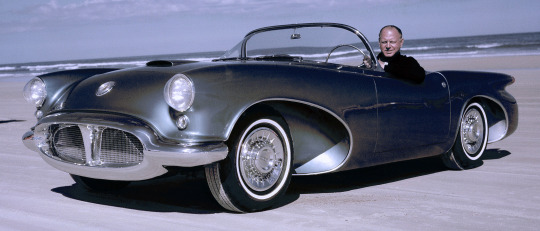


Oldsmobile F88 Concept, 1956. This was Oldsmobile's version of the first generation Corvette that was first shown in 1954 and was powered by a 324ci Rocket V8 rather than the C1 Corvette's straight 6.
#Oldsmobile#Oldsmobile F88#concept#prototype#C1 Corvette#1956#GM Motorama#sports car#General Motors#Rocket V8#dead brands#design study
488 notes
·
View notes
Text

Oldsmobile F88 ..Motorama concept
56 notes
·
View notes
Text






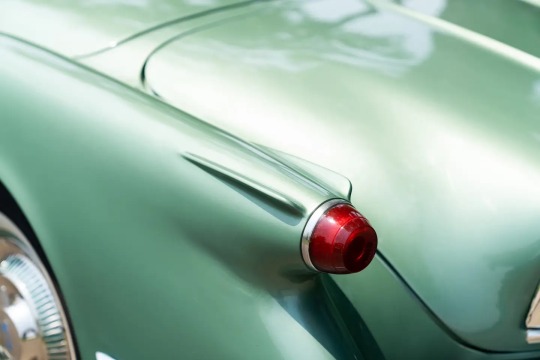



1954 Chevy Corvette C1
The origins of this prototype, which is known by its S.O. 2151 serial number, date back to early 1953, before the ‘Vette had even gone into production.
It’s one of 15 cars with a single-piece fiberglass body that were built for testing or display at GM Motorama. This example debuted in early 1954 as a pale-yellow hard-top, after which it was retired and sent to GM’s storied Art and Colour department for use as a proposal car.
Under the supervision of legendary designer Harley Earl, the car would end up being used as a design prototype for the 1955 Corvette, which was due to get a makeover to go with its new, optional V-8.
The vehicle’s body features several stylistic changes, including a new egg-crate front grille, a decorative hood scoop, slanted front-fender vents, bumper-exit exhaust tips, and a trunk like that found on the fastback Corvair.
The convertible, which is powered by an inline-six and finished in Bermuda Green, is a beauty, but as Corvette buffs know, GM executives decided to hold off for a year and then go in a more muscular direction withIt’s unclear what happened to the S.O. 2151 after GM passed on it, but at some point during the 1960s it fell into private ownership with most of its unreleased cosmetic features removed. In 1975, it was purchased for $3,000 by George F. Campbell, who bought it based on the advice of Corvette historian Noland Adams.
Campbell then spent the next four decades researching the prototype and collecting parts so that it could be restored to its 1954 appearance and specification. Unfortunately, Campbell passed away before this could happen, but its current owner had the car restored back to its original glory late last decade.
The car has only been displayed once since then, at this year’s Amelia Concours d’Elegance, where it received the prestigious Founder Award. the 1956 model.
#art#design#supercars#luxurycars#supercar#luxurylifestyle#luxurycar#vintage cars#one-off#corvette#chevy#chevy corvette#corvette C1#GM#1954#restomod
261 notes
·
View notes
Text

Chevrolet Corvette Nomad
Back in the mid-’50s, GM held the Motorama traveling car show. It features some crazy concepts, future cars, and promotional materials. Those were the glory days of the American concept car trend. Each year, manufacturers competed with different cars that later became car styling and pop culture icons. In 1954, Chevrolet presented the Corvette Nomad. They named it the Waldorf Nomad since it first appeared at the Waldorf Astoria Hotel. It was practically a Corvette station wagon, but the design proved to be influential. Chevrolet presented the Nomad as a three-door station wagon.

It became part of the mainline Chevrolet model lineup just a year later. Also, the Corvette Nomad was one of the most popular concept cars from the Motorama period. After their short lives on the show circuit around America, most concept cars went to the crusher, but some managed to survive. This is where the Corvette Nomad case gets strange. Since it was a fully functional vehicle, the chances are they sold it, possibly to an employee or dealer. There are no records to show they crushed this car, but there are no records to prove someone bought it, either. It vanished in the mid-1950s and Corvette fans have been searching for it ever since.
67 notes
·
View notes
Text

#cars#car#classic#classic cars#classic car#concept#concept car#vintage#general motors#firebird#firebird ii
97 notes
·
View notes